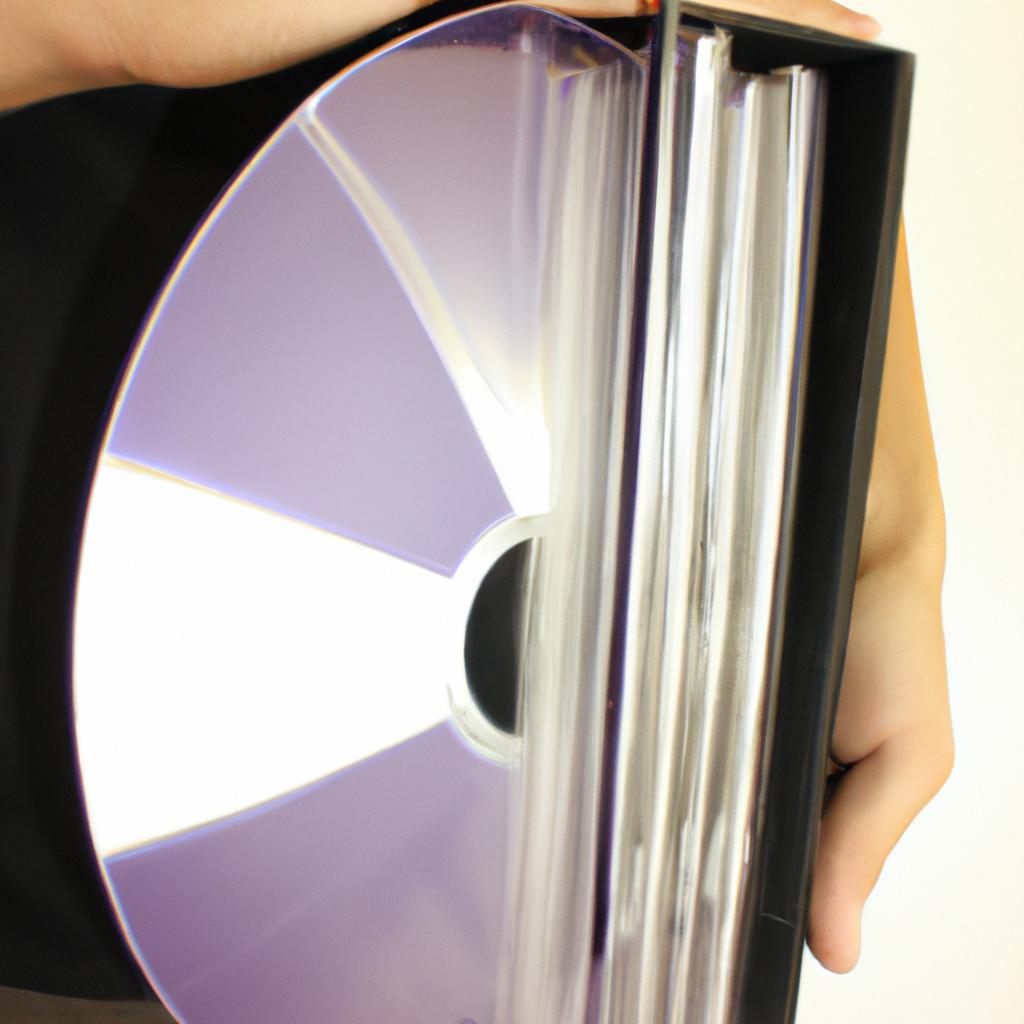Horror movies have long fascinated audiences, captivating them with their ability to evoke fear and suspense. For DVD movie sellers, understanding the appeal of horror films is crucial for effectively reaching their target market and maximizing sales. This article serves as a comprehensive guide for DVD movie sellers looking to navigate the world of horror movies, providing insights into the genre’s popularity, key elements that make a successful horror film, and strategies for marketing these spine-chilling cinematic experiences.
To illustrate the significance of horror movies in the DVD market, let us consider a hypothetical case study: Smith’s Movies, an online retailer specializing in DVDs, noticed a surge in demand for horror films during the Halloween season. Curious about this trend, they decided to analyze customer behavior and preferences further. Their findings revealed that customers were not only seeking traditional slasher or supernatural horror films but also expressing interest in subgenres such as psychological thrillers and found footage films. Armed with this knowledge, Smith’s Movies was able to curate a diverse collection of horror movies tailored to meet their customers’ evolving tastes.
Understanding what draws audiences to horror films is essential when targeting potential buyers. The allure lies in experiencing intense emotions like fear and anxiety within a controlled environment. Horror movies offer an escape from reality while simultaneously providing a thrilling and adrenaline-pumping experience. For many viewers, the appeal of horror films lies in the adrenaline rush that comes from being scared, but knowing that it is all just fiction. This can be a cathartic release for some individuals, allowing them to safely explore their own fears and anxieties.
In addition to the emotional aspect, horror movies often tap into our innate curiosity about the unknown and the supernatural. They offer a glimpse into worlds beyond our understanding, exploring themes such as monsters, ghosts, and the occult. This combination of fear and fascination keeps audiences captivated and coming back for more.
When it comes to creating successful horror films, several key elements contribute to their popularity. Firstly, an engaging storyline is crucial. Audiences want to be invested in the characters’ journeys and feel connected to their experiences. A well-crafted plot with unexpected twists and turns can keep viewers on the edge of their seats.
Secondly, effective use of suspense and tension is essential in building anticipation and creating a sense of unease. Filmmakers employ various techniques such as eerie sound design, clever camera angles, and skillful editing to create moments that make audiences jump or hold their breaths in anticipation.
Thirdly, memorable villains or monsters are often central to successful horror movies. Iconic figures like Freddy Krueger from “A Nightmare on Elm Street” or Jason Voorhees from “Friday the 13th” have become synonymous with the genre itself. These characters not only frighten viewers but also become cultural icons that fans love to embrace.
Finally, it’s important for DVD movie sellers to effectively market horror films to their target audience. Leveraging social media platforms allows for targeted advertising campaigns where promotions can be tailored specifically towards horror enthusiasts. Collaborating with influencers or partnering with relevant websites or blogs dedicated to horror movies can also help generate buzz around new releases.
By understanding the appeal of horror films and the key elements that make them successful, DVD movie sellers can curate a collection that caters to the diverse tastes of horror fans. With effective marketing strategies in place, they can capitalize on the genre’s popularity and maximize sales in this ever-thriving market.
Different Types of Horror Movies
One popular subgenre within horror movies is supernatural horror. These films often involve paranormal entities or occurrences that go beyond the natural world. For example, “The Conjuring” franchise has gained a significant following due to its ability to evoke fear through ghostly apparitions and demonic possessions. These types of movies tend to captivate viewers by tapping into their fears of the unknown and their belief in the existence of supernatural forces.
Another type of horror movie is psychological horror. Unlike supernatural horror, these films focus on the inner workings of the human mind and explore themes such as paranoia, obsession, and mental instability. A classic example of this genre is Alfred Hitchcock’s “Psycho,” which delves into the disturbed mind of Norman Bates. Psychological horror relies heavily on suspense and tension-building techniques to unsettle audiences, playing with their deepest anxieties and challenging their perception of reality.
Additionally, there are slasher films that center around a masked killer who terrorizes unsuspecting victims. These movies often feature graphic violence, intense chase sequences, and high body counts. The iconic character Michael Myers from John Carpenter’s “Halloween” exemplifies this subgenre’s popularity. Slasher movies aim to shock and frighten viewers through gory imagery and unexpected deaths.
To further understand the diversity within the horror genre, consider the following emotional responses commonly associated with different types of horror movies:
- Fear: Supernatural horrors create an atmosphere filled with dread and anticipation.
- Suspense: Psychological horrors keep audiences on edge by manipulating their emotions.
- Shock: Slasher films provide shocking moments through violent scenes and sudden scares.
- Disgust: Some horror movies rely on grotesque visuals or disturbing concepts to evoke disgust in viewers.
Emotional Response Examples:
| Subgenre | Emotional Response |
|---|---|
| Supernatural Horror | Fear |
| Psychological Horror | Suspense |
| Slasher Films | Shock |
| Gore Horror | Disgust |
In summary, horror movies encompass a wide range of subgenres that cater to different fears and emotional responses. By understanding the distinct characteristics of supernatural horror, psychological horror, and slasher films, DVD movie sellers can effectively curate their collections to meet the diverse preferences of their customers.
Moving forward to explore factors that should be considered when selecting horror movies for sale…
Factors to Consider When Choosing Horror Movies for Sale
When selecting horror movies to sell, there are several important factors that DVD movie sellers need to consider. One such factor is the target audience of the movie. For example, if a store primarily caters to teenage horror enthusiasts, it would be beneficial to stock up on slasher films like “Halloween” or “Scream.” On the other hand, if the target audience consists of more mature viewers who appreciate psychological thrillers, movies such as “The Shining” or “Psycho” may be more suitable.
In addition to considering the target audience, another crucial factor is the film’s rating and content. Some customers may prefer less graphic and violent horror movies, while others seek out explicit gore and intense scares. By offering a diverse selection that includes both mild and extreme options, DVD movie sellers can cater to a wider range of preferences. This approach allows customers to find something they feel comfortable watching without compromising their desire for thrilling experiences.
Moreover, considering popular trends in horror cinema can greatly impact sales. Monitoring which sub-genres are currently in high demand enables vendors to adjust their inventory accordingly. For instance, during periods when supernatural-themed movies gain popularity (such as with franchises like “Paranormal Activity”), stocking up on similar titles could attract customers looking for those specific types of films.
To summarize, when choosing horror movies for sale:
- Identify the target audience and select films tailored to their interests.
- Offer a variety of ratings and content levels.
- Stay informed about current trends in horror cinema.
- Adapt your inventory based on market demands.
By taking these factors into account, DVD movie sellers can ensure they have an appealing selection that meets customer expectations and drives sales.
Now transitioning into the subsequent section about Popular Horror Movie Franchises…
Popular Horror Movie Franchises
Factors to Consider When Choosing Horror Movies for Sale
In the previous section, we discussed various factors that sellers should consider when choosing horror movies for sale. Now, let’s delve deeper into these factors and explore their significance in more detail.
One crucial factor to consider is the target audience. Understanding who your customers are will help you select horror movies that cater to their preferences and interests. For example, if your target audience consists mainly of teenagers, you might want to focus on modern supernatural horror films like “The Conjuring” series or psychological thrillers such as “Get Out.” By aligning your movie selection with the tastes of your target audience, you can increase the likelihood of attracting potential buyers.
Another important consideration is the subgenre of horror. There are numerous subgenres within the realm of horror, ranging from slasher films to paranormal activity. Offering a diverse range of subgenres allows you to appeal to different customer preferences. To illustrate this point, imagine a scenario where a customer visits your store looking specifically for a found footage horror film. If you have a comprehensive collection that includes popular titles like “Paranormal Activity” and lesser-known gems like “Creep,” they are more likely to find what they’re looking for and leave satisfied.
To assist you further in understanding these considerations, here is a list summarizing some key points:
- Target Audience: Identify who your customers are and choose movies that resonate with their demographic.
- Subgenres: Offer a wide variety of subgenres within the horror genre to attract customers with varying preferences.
- Cult Classics: Include cult classic horror movies like “Halloween” or “Nightmare on Elm Street,” as these often have dedicated fan bases.
- International Films: Don’t limit yourself solely to Hollywood productions; include internationally acclaimed horror films like “Train to Busan” or “REC.”
Additionally, visual aids can enhance our understanding of these factors. The following table provides a comparison of different subgenres and their characteristics:
| Subgenre | Example Films | Characteristics |
|---|---|---|
| Supernatural | “The Conjuring” series | Involves supernatural elements like ghosts, demons, or haunted houses. Often focuses on suspense and jump scares. |
| Slasher | “Halloween,” “Friday the 13th” | Features a killer who stalks and murders victims, often using bladed weapons. Known for its high body count and graphic violence. |
| Psychological | “Get Out,” “Black Swan” | Emphasizes psychological tension and manipulation of the mind. Explores themes such as paranoia, identity, and mental illness. |
| Found Footage | “Paranormal Activity,” “Creep” | Present footage as if shot by characters in the movie themselves. Creates an immersive experience that generates realism through shaky camera movements and natural lighting. |
In conclusion to this section, understanding your target audience’s preferences and offering a diverse selection of horror movies across various subgenres are crucial factors when choosing films to sell. By considering these aspects carefully, you can ensure that your inventory appeals to a wide range of customers’ tastes while also providing niche options for specialized interests.
Moving forward into the next section on ‘Tips for Marketing Horror Movies,’ let’s explore strategies that can help you effectively promote your horror film collection.
Tips for Marketing Horror Movies
Section: Popular Horror Movie Franchises and their Impact
When it comes to horror movies, there are certain franchises that have become household names. These franchises not only captivate audiences with their terrifying stories but also leave a lasting impact on the genre as a whole. One such example is the “Halloween” franchise, which began in 1978 with John Carpenter’s iconic slasher film.
The success of the “Halloween” franchise can be attributed to several factors that set it apart from other horror movie series:
- Consistency: The “Halloween” franchise has maintained a consistent level of quality throughout its various installments. Each film builds upon the original story while introducing new elements to keep audiences engaged.
- Iconic Villain: Michael Myers, the masked killer at the center of the “Halloween” franchise, has become one of the most recognizable figures in horror cinema. His menacing presence and relentless pursuit of his victims create an atmosphere of fear that resonates with viewers.
- Fan Engagement: The “Halloween” franchise understands the importance of engaging with its fan base. Through conventions, merchandise, and interactive experiences, fans feel connected to the world of Michael Myers beyond just watching the films.
- Legacy: Over four decades after its inception, the “Halloween” franchise continues to inspire new filmmakers and influence future horror movies. Its impact extends beyond box office success; it has left an indelible mark on pop culture.
To further illustrate this phenomenon, consider the following table showcasing some popular horror movie franchises and their respective impacts:
| Franchise | Notable Films | Impact |
|---|---|---|
| Halloween | Halloween (1978), Halloween (2018) | Defined slasher genre; enduring fandom |
| Friday the 13th | Friday the 13th (1980), Jason Lives (1986) | Popularized hockey mask-wearing killer |
| Nightmare on Elm Street | A Nightmare on Elm Street (1984), New Nightmare (1994) | Introduced supernatural horror in dreams |
| Saw | Saw (2004), Jigsaw (2017) | Revitalized the “torture porn” subgenre |
These franchises, among others, have become staples of the horror genre and continue to capture the imaginations of audiences worldwide.
Understanding the impact of popular horror movie franchises is crucial for DVD movie sellers. By recognizing their significance and incorporating them into marketing strategies, sellers can attract a broader audience and boost sales. In the following section, we will explore tips for effectively marketing horror movies with a focus on leveraging reviews to maximize sales.
Transition sentence: As DVD movie sellers navigate the world of horror films, it is important to consider how reviews influence consumer choices and ultimately impact sales.
The Impact of Reviews on Horror Movie Sales
Reviews play a crucial role in the success or failure of horror movies. Positive reviews can generate buzz and attract audiences, while negative reviews can deter potential viewers. In this section, we will explore the impact that reviews have on horror movie sales using a hypothetical example to illustrate their influence.
The Influence of Reviews:
To understand the impact of reviews on horror movie sales, let us consider a fictional film titled “Nightmare Manor.” Upon its release, “Nightmare Manor” received mixed reviews from critics. While some praised its suspenseful storyline and chilling atmosphere, others criticized its predictable plot and lackluster performances. This divergence in opinions had significant consequences for the movie’s box office performance.
When it comes to horror movie reviews, here are four emotional responses that can affect audience perception and ultimately influence purchasing decisions:
- Fear: Positive reviews praising the intense scares and heart-pounding moments can pique curiosity among horror enthusiasts.
- Disappointment: Negative critiques highlighting clichéd jump scares or weak character development may discourage potential viewers.
- Intrigue: Ambiguous or mysterious reviews teasing unexpected twists and turns can create anticipation and drive ticket sales.
- Indifference: A lack of attention or mediocre ratings might lead audiences to overlook a particular horror movie altogether.
Table – Review Scores Comparison:
| Outlet | Score (out of 10) |
|---|---|
| HorrorHound | 8 |
| FrightFest | 7 |
| Screamers | 6 |
| TerrorTimes | 4 |
This table displays review scores given by different outlets for “Nightmare Manor,” showcasing varying levels of acclaim. Such disparities in reviewer assessments contribute to divergent audience reactions and subsequent purchasing behavior.
Conclusion Transition:
As we have seen, reviews hold great sway over horror movie sales. Understanding the impact of reviews can help DVD movie sellers tailor their marketing strategies accordingly.
Understanding the Target Audience for Horror Movies
Transitioning from our previous discussion on the impact of reviews on horror movie sales, we now turn our attention to understanding the target audience for these thrilling and spine-chilling films. By gaining insights into the preferences and characteristics of horror movie enthusiasts, DVD movie sellers can craft effective marketing strategies that resonate with their potential customers.
To illustrate this further, let us consider a hypothetical case study involving a newly released horror film titled “Nightmare Mansion.” The film features elements of psychological suspense, supernatural occurrences, and intense jump scares. Through an analysis of its target audience, we can gain valuable insights into what drives fans of such movies:
- Psychological Thrills: One key aspect that often entices horror movie aficionados is their desire for psychological thrills. They seek out films that challenge their minds and keep them at the edge of their seats, wondering what might happen next.
- Adrenaline Rush: For many viewers, the adrenaline rush experienced while watching a horror movie is a significant draw. The combination of fear and excitement provides an exhilarating experience that keeps them engaged throughout the film’s duration.
- Escapism: Horror movies offer a means of escapism for some individuals who enjoy immersing themselves in fictional worlds filled with tension and suspense. These viewers may find solace in temporarily disconnecting from reality and diving into terrifying narratives.
- Social Bonding: Some horror movie enthusiasts also appreciate the communal aspects associated with watching these films together with friends or family members. Sharing frightful experiences can strengthen social bonds and create lasting memories.
To delve deeper into understanding the target audience for horror movies, let us examine Table 1 below showcasing demographic information collected through surveys conducted among frequent consumers:
Table 1: Demographic Profile of Frequent Consumers
| Age Group | Gender | Education Level | Occupation |
|---|---|---|---|
| 18-25 | Male | College Degree | Student |
| 26-35 | Female | High School | Office Administrator |
| 36-45 | Non-binary | Some College | Freelance Writer |
| 46+ | Prefer not to disclose | Graduate Degree | Software Engineer |
From the table above, it becomes evident that horror movie enthusiasts encompass a diverse range of individuals from various age groups and backgrounds. Understanding this demographic profile allows DVD movie sellers to tailor their marketing strategies accordingly.
In conclusion, by recognizing the preferences and characteristics of the target audience for horror movies, DVD movie sellers can effectively appeal to potential customers. Psychological thrills, adrenaline rushes, escapism, and social bonding are significant factors driving fans of these films. The demographic diversity among frequent consumers further emphasizes the need for customized approaches when promoting horror movies to maximize sales opportunities.





